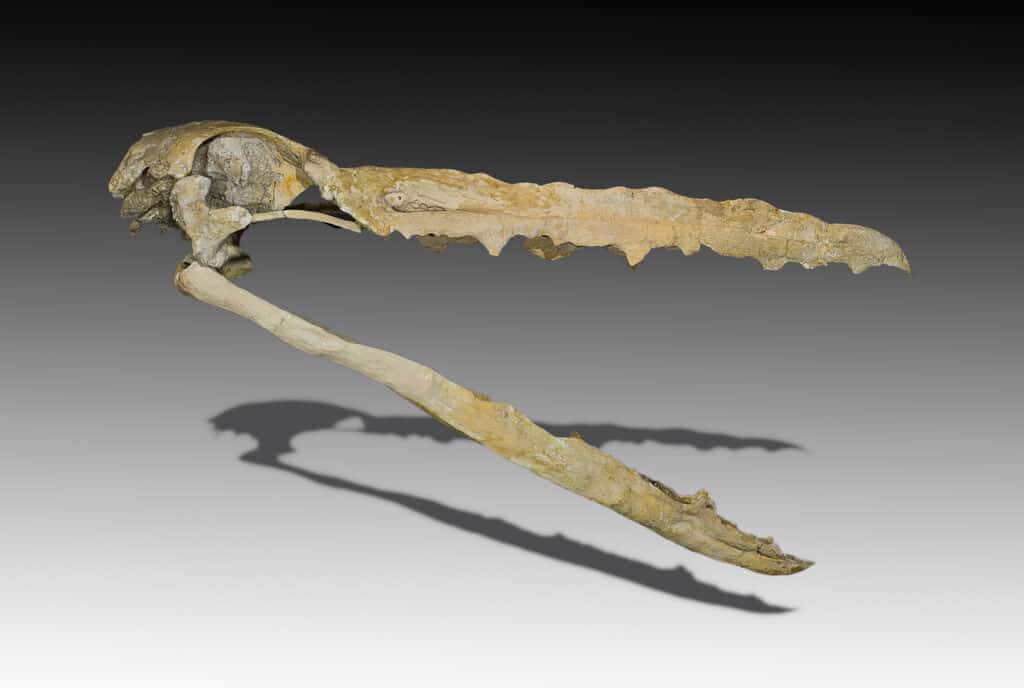The Pelagornis is larger than the largest living bird today.
Advertisement
Pelagornis Scientific Classification
- Kingdom
- Animalia
- Phylum
- Chordata
- Class
- Aves
- Order
- Odontopterygiformes
- Family
- Pelagornithidae
- Genus
- Pelagornis
- Scientific Name
- Pelagornis
Read our Complete Guide to Classification of Animals.
Pelagornis Conservation Status
Pelagornis Facts
- Prey
- Fish
- Fun Fact
- The Pelagornis is larger than the largest living bird today.
- Most Distinctive Feature
- Massive wingspan of up to 20 feet
- Wingspan
- Up to 20 feet
- Habitat
- Coastal near oceans
- Predators
- Sharks and large land carnivores
- Diet
- Carnivore
- Favorite Food
- Fish
- Number Of Species
- 4
- Location
- North America, South America, Europe, Australia
Pelagornis Physical Characteristics
- Skin Type
- Feathers
- Length
- 20-foot wingspan
- Venomous
- No
- Aggression
- Low
View all of the Pelagornis images!
Pelagornis, a prehistoric seabird, was bigger than even the largest bird alive today.
Living during the Eocene to the Pleistocene, Pelagornis lived near the ocean and was capable of flying great distances by gliding. Similar to modern pelicans, storks, or albatross, Pelagornis ate fish and dominated the prehistoric skies. Want to learn more? After reading about these prehistoric birds, you can actually visit many of the sites where they were discovered and look for them yourself!
Pelagornis Facts
- Their wingspan could get up to 20 feet across or more.
- They did not have actual teeth. Instead, they caught prey in tooth-like growths on their beak.
- Pelagornis could fly across oceans, which explains why their fossils have been discovered all around the world.
- They went extinct in the early Pleistocene, around 11,700 years ago.
- Sharks and large land mammals would have been predators of the giant Pelagornis.
Description & Size
These prehistoric birds were similar to pelicans and storks, with wide wingspans that helped them take advantage of sea breezes to fly. Its wingspan was probably around 15 to 16 feet long, although some species within the genus had even wider wingspans. For example, the Pelagornis sandersi is the largest flying bird ever discovered and had a wingspan that was over 20 feet wide.
With such a large body, it’s amazing that these giant birds were actually able to fly. They probably had long feathers to help generate lift. They had long heads and beaks as well. Their heads could get up to 16 inches long. They had teeth-like structures on their beak as well. These were not actual teeth that connected to their jaw. Instead, they grew out of their beak. They were still likely used to help them catch and eat prey, however.

Pelagornis had a long beak with multiple layers of teeth, allowing it to catch, hold, and swallow prey.
©Didier Descouens / Creative Commons Attribution-Share Alike 4.0 International license – License
Diet – What did Pelagornis eat?
The Pelagornis had teeth along their beak. However, they were not a uniform size. Smaller teeth were present between their larger teeth. These likely served different purposes when they ate their food, helping them to tear into prey, chew, and swallow. Based on fossil evidence, Pelagornis lost these teeth-like structures periodically. They later grew back.
Because it was a sea bird and lived near the ocean, the Pelagornis almost certainly ate fish. Like modern pelicans and storks, it probably snatched and scooped them up out of the water with its large beak. The albatross, which is the largest bird currently alive, flies close to the surface of the ocean using the current to stay aloft. It is likely that Pelagornis did something similar due to its large size. These birds would have been better gliders than active flyers. Staying close to the water would have also made it easier for them to get food.
Habitat — When and Where It Lived
Pelagornis fossils have been discovered around the world, including along both the East and West Coasts of the United States, Western Europe, and South America. They lived near water, specifically large bodies of water such as oceans. These birds would have been large enough to glide and fly across vast oceans, which accounts for their wide distribution around the world.
They lived during the Eocene to early Pleistocene, between 56 million and 11,700 years ago. These seabirds lived during periods of great change for the earth. It is notable that they lived for so long and likely saw many different kinds of predators come and go. They were able to adapt to their changing environment for millions of years.
Threats and Predators
When Pelagornis first appeared in the Eocene, it would have faced threats from Creodonts, carnivorous land mammals that lived during the Eocene and Miocene periods. There were many species but only the largest, such as Megistotherium, would have been able to get to the large Pelagornis. Because they could fly, these sea birds were probably adept at escaping predators.
No eggs or nests have been discovered, so scientists do not know very much about juvenile Pelagornis. However, based on their similarities to modern birds, most believe that they laid eggs and their young hatched relatively small and helpless. Both the eggs and the newly hatched Pelagornis would have been more vulnerable to predators.
They ate fish and other aquatic life, possibly even squids. The tooth-like projections on their beaks would have helped them catch them without slipping and keep hold of their prey. While fishing or flying low to the water, Pelagornis would have been targeted by carnivorous marine animals, such as sharks.
Discoveries and Fossils – Where It Was Found
Pelagornis had thin, fragile bones, especially in their wings. Because of this, many of their bones have not been preserved or fossilized. So far, no complete skeleton has been discovered. The fossils that have been found are usually fragments, although Pelagornis skulls are usually in better shape and tell scientists a lot about how they lived.
The Chandler Bridge Formation in South Carolina, the Calvert Formation in Maryland and Virginia, and the Pungo River Formation in North Carolina are all sites where Pelagornis fossils were discovered. Other places include Portugal and Morocco. The specimen discovered in Morocco was the oldest one, dating to the Eocene. It consisted of fragments of their beaks and bones.
One discovery in Australia showed just how far and wide these birds could travel. While many of the Pelagornis specimens were found on the East Coast of the United States, South America, and Western Europe, a bone fragment dated to 5 million years ago was found in Beaumaris, Victoria. They were discovered by the public. Many of the sites where Pelagornis fossils have been found are open to amateur sleuths who like to look for fossils as well as professionals.
Extinction – When did it die out?
It is unclear why exactly the Pelagornis went extinct but fossils show that these birds died out around 11,700 years ago. Because the climate was changing so much at the time, with glaciers melting and seasons going through massive shifts, it is likely that the Pelagornis either couldn’t find enough food or was not able to withstand the elements. Like many prehistoric mammals, they did not evolve and adapt fast enough to outpace the rapidly changing earth.
Similar Animals to the Pelagornis
View all 192 animals that start with PPelagornis FAQs (Frequently Asked Questions)
When were Pelagornis alive?
These giant birds lived from the Eocene to the Early Pleistocene, between 56 million and 11,700 years ago.
How big were Pelagornis?
Due to a lack of a complete skeleton, it’s hard to say how tall or long the Pelagornis was. However, scientists do know that they had a massive wingspan, which could be up to 20 feet across.
Thank you for reading! Have some feedback for us? Contact the AZ Animals editorial team.
Sources
- Melbourne Museum, Available here: https://museumsvictoria.com.au/melbournemuseum/state-fossil-emblem/pelagornis/
- AMNH Digital Library, Available here: https://digitallibrary.amnh.org/handle/2246/6096
- Britannica, Available here: https://www.britannica.com/animal/Creodonta

















